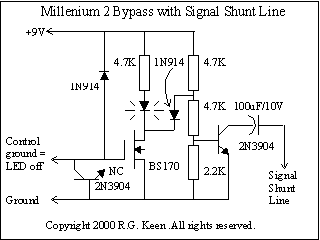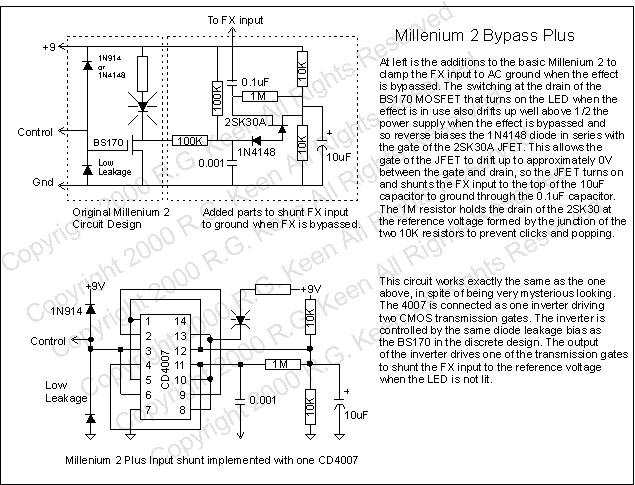More Fun With the Millenium 2 Bypass
Copyright 2000 R.G. Keen. All rights reserved.
No permission for local copies or serving from web sites other than http://www.geofex.com.
When I get asked to dream up some effect circuit, usually the
problem is how to pick out only one of the ways to do this. This is one of those
problems. A reader asked for a way to use the Millenium Bypass but to still have
a way to shunt the input of an effect to ground to suppress oscillation or noise
from an effect input floating, as it does with the hard-switching arrangement of
the Millenium. I came up with three ways to do this, each using a different mix
of parts.
The least-fancy one first:
 The basic
Millenium 2 is shown at left. The leakage from the 1N914 pulls the gate of the
BS170 up whenever the control line is opened, so the light is turned on. When
that happens, the drain of the BS170 is pulled to ground. Adding a signal diode
for isolation and three resistors to drive the base of a bipolar transistor
(2N3904) lets this same signal turn the OFF the bipolar transistor when the LED
is on. This corresponds to when the effect is engaged.
The basic
Millenium 2 is shown at left. The leakage from the 1N914 pulls the gate of the
BS170 up whenever the control line is opened, so the light is turned on. When
that happens, the drain of the BS170 is pulled to ground. Adding a signal diode
for isolation and three resistors to drive the base of a bipolar transistor
(2N3904) lets this same signal turn the OFF the bipolar transistor when the LED
is on. This corresponds to when the effect is engaged.
When the effect is bypassed (LED off) we want the bipolar
transistor to turn on. When it's on, the transistor looks like a low resistance
to ground, maybe under 50 ohms for garden varieties of transistors, as low as 2
ohms for some specialized ones. The collector is isolated from any DC by the
100uF capacitor and the signal shunt line may be connected to the input of the
effect being controlled. When the transistor is on, it shunts the input of the
effect to ground through its low collector-to-emitter saturation resistance.
Another way to do this is with a JFET or MOSFET as a shunt
device.
 The
illustration at right shows two ways. In the first, similar to the first, the
BS170 drain pulls down a signal that controls the shunting element. In this
case, it's a 2SK30A JFET. This JFET is biased so that it forms a low impedance
to ground through the 0.1uF cap and the 10uF cap in its source bias string.
The
illustration at right shows two ways. In the first, similar to the first, the
BS170 drain pulls down a signal that controls the shunting element. In this
case, it's a 2SK30A JFET. This JFET is biased so that it forms a low impedance
to ground through the 0.1uF cap and the 10uF cap in its source bias string.
The last method is essentially the same as the JFET method, but
it uses the individual MOSFET transistors in a CD4007 IC to implement both the
primary switching of the Millenium, as well as the shunting output. In
invite you to draw out the internals to understand how it's working.
 The basic
Millenium 2 is shown at left. The leakage from the 1N914 pulls the gate of the
BS170 up whenever the control line is opened, so the light is turned on. When
that happens, the drain of the BS170 is pulled to ground. Adding a signal diode
for isolation and three resistors to drive the base of a bipolar transistor
(2N3904) lets this same signal turn the OFF the bipolar transistor when the LED
is on. This corresponds to when the effect is engaged.
The basic
Millenium 2 is shown at left. The leakage from the 1N914 pulls the gate of the
BS170 up whenever the control line is opened, so the light is turned on. When
that happens, the drain of the BS170 is pulled to ground. Adding a signal diode
for isolation and three resistors to drive the base of a bipolar transistor
(2N3904) lets this same signal turn the OFF the bipolar transistor when the LED
is on. This corresponds to when the effect is engaged.  The
illustration at right shows two ways. In the first, similar to the first, the
BS170 drain pulls down a signal that controls the shunting element. In this
case, it's a 2SK30A JFET. This JFET is biased so that it forms a low impedance
to ground through the 0.1uF cap and the 10uF cap in its source bias string.
The
illustration at right shows two ways. In the first, similar to the first, the
BS170 drain pulls down a signal that controls the shunting element. In this
case, it's a 2SK30A JFET. This JFET is biased so that it forms a low impedance
to ground through the 0.1uF cap and the 10uF cap in its source bias string.